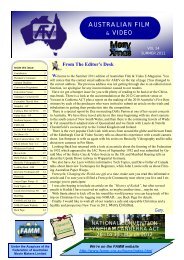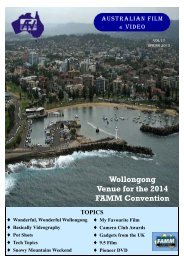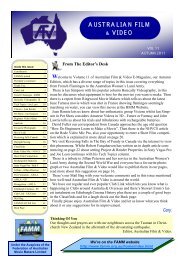Australian film - Federation of Australian Movie Makers
Australian film - Federation of Australian Movie Makers
Australian film - Federation of Australian Movie Makers
Create successful ePaper yourself
Turn your PDF publications into a flip-book with our unique Google optimized e-Paper software.
Editing:<br />
The more detail you can clearly and naturally include<br />
in a shot, the less need will there be for you to draw<br />
attention to any <strong>of</strong> its parts in separate, closer shots.<br />
This should mean 16x9 format shots are longer in duration.<br />
However, is this necessarily so in the modern<br />
cinema?<br />
Walking room right <strong>of</strong> frame needs to be maintained if the<br />
shot includes a pan.<br />
Cutting out the Cut<br />
In the early years <strong>of</strong> widescreen cinema there developed<br />
the view that the editing styles <strong>of</strong> the 4x3 format<br />
were now obsolete. Such an example comes from<br />
Henry Koster, director <strong>of</strong> the first Cinemascope <strong>film</strong>, The Robe, when he asserted that a cut into a close up<br />
was now unnecessary, since virtually every detail in the shot was magnified and hence easy to see. This<br />
impulsive response forgot that cutting to a close up was more than showing detail it was also used to emphasise,<br />
to create context and to enhance or suggest significance. Nevertheless the <strong>film</strong> theorists and the<br />
writers to the magazine, Cahiers du cinema, hailed the widescreen format as making editing less important.<br />
Or expressed another way they saw “cutting” in widescreen <strong>film</strong>s moving from the editor to the director.<br />
This reduced dependence on the post production <strong>of</strong> the editing bench was heralded as producing more<br />
“natural” <strong>film</strong>s, <strong>film</strong>s with greater authenticity and objectivity. Another spin <strong>of</strong>f <strong>of</strong> course was the greater<br />
use <strong>of</strong> the mobile camera, longer takes and compositional depth. The first two are forever with us now on<br />
widescreen TV, whilst the latter seems to fallen out <strong>of</strong> favour.<br />
Scene Length – How Long?<br />
In the early years <strong>of</strong> widescreen cinema the accepted view was that longer scene lengths were needed because<br />
it took time for the audience to become accustomed with each new scene. Or as the <strong>film</strong> theorists<br />
such as Barr would express it, the wider frame encouraged “greater physical involvement” and so encouraged<br />
the audience to “interpret” and / or “read the shot.” All <strong>of</strong> which took time and hence the widescreen<br />
shots had to be longer.<br />
Scene Length (seconds)<br />
25<br />
20<br />
15<br />
10<br />
5<br />
0<br />
1953-55<br />
1959 Current 1953-55<br />
Widescreen<br />
Time period<br />
4x3 Format<br />
However, as the graph indicates, as<br />
the audiences became more acquainted<br />
with the widescreen format<br />
and as directors learned to better employ<br />
the widescreen format, then shot<br />
lengths decreased until now there is<br />
no significant difference in shot<br />
lengths between widescreen <strong>film</strong>s and<br />
pre-widescreen <strong>film</strong>s.<br />
What can We learn from the Last 50<br />
Years <strong>of</strong> Widescreen Films?<br />
So what can we, new 16x9 videographers,<br />
gauge from all <strong>of</strong> the experience<br />
<strong>of</strong> the last 50 years? In brief not<br />
a lot changes when you move from 4x3 to 16x9. Editing techniques learned in the 4x3 format can still be<br />
applied to the 16x9 format. Shot lengths don’t have to be longer, unless that is the mood or rhythm you<br />
wish to achieve. The Rule <strong>of</strong> Thirds still applies to the wider frame. Horizontal and diagonal compositions<br />
do look better in 16x9. Be aware <strong>of</strong> what is happening in the foreground <strong>of</strong> the 16x9 frame lest it overpowers<br />
action in the rest <strong>of</strong> the frame. However, on the other hand you can take advantage <strong>of</strong> the wider frame<br />
to capture two related actions; (say) a foreground action <strong>of</strong> a child on a swing and a background <strong>of</strong> a parent<br />
carefully watching. Be cautious in the use <strong>of</strong> big close-ups and rapid scene changes in the widescreen format<br />
as they have a more dramatic effect on the audience. In short enjoy your new found frame area and<br />
creatively use it!<br />
Max<br />
Min<br />
<strong>Australian</strong> <strong>film</strong> & video<br />
Page 15










